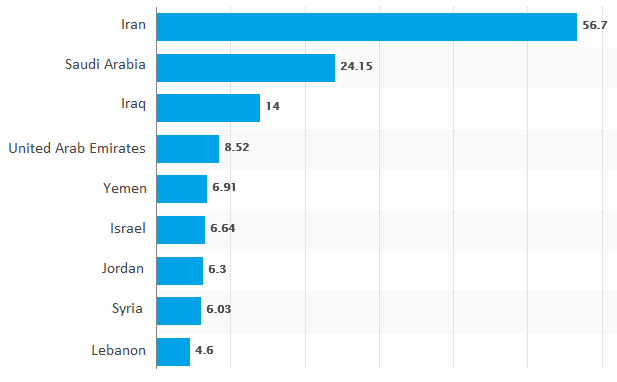IELTS graph 305 - Internet users in the Middle East in June 2017
- Details
- Last Updated: Tuesday, 11 June 2019 15:18
- Written by IELTS Mentor
- Hits: 37986
IELTS Academic Writing Task 1/ Graph Writing - Pie Charts:
You should spend about 20 minutes on this task.
The chart below shows the internet users (in millions) in different countries in the Middle East as of June 2017.
Summarise the information by selecting and reporting the main features, and make comparisons where relevant.
You should write at least 150 words.
Internet users in million - June 2017

Model Answer 1:
The bar chart outlines the number of internet users in nine Middle-Eastern countries as of June 2017. A glance at the bar chart reveals that Iran by far had the highest internet users while it was the lowest in Lebanon.
The diagram outlines that, more than 56 million Iranian citizens were connected to the internet in June 2017. During that time, Saudi Arabia had the second largest number of netzines, citizens who use the internet, where more than 24 million citizens had access to the internet. Iraq with exactly 14 million internet subscribers was in the distant third while this number in the United Arab Emirates was roughly eight and a half million. The numbers of citizens who had internet connections in countries like Yemen, Israel, Jordan and Syria were somewhat 6 million in each country. Finally, with the least number of internet users (4.6 million only) Lebanon stood at the bottom of the list.
Sample Answer 2:
The bar graph reveals the number of internet users in June 2017 in nine different countries in the Middle East. As a general trend, Iran and Saudi Arabia had far more internet users than that of the remaining countries.
According to the diagram, among the Middle-Eastern countries, Iran had the highest number of internet users in June 2017 which was well over 56 million. With exactly 24.15 million internet users, Saudi Arabia stood at the second position in the list. Besides,14 million Iranians were connected to this digital world which was significantly fewer than that of Iranian and Saudi Arabian internet users, but notably higher than that of most other Arab countries. Interestingly, Yemen, Israel, Jordan and Syria had a similar number of internet subscribers that ranges from approximately 6 to 7 million. Finally, in the United Arab Emirates, just over 8.5 million citizens had access to the internet in June 2017 and the lowest number of internet users in a country was from Lebanon, where fewer than 5 million people had access to the internet technology.

It is evident that Iran constituted the highest number of internet users while Lebanon had the least. Remaining countries were in their subsequent positions in the year 2017.
In details, among the given Middle Eastern countries, Iran had the maximum number, 56.7 million, internet users. Saudi Arabia with 24.15 million and Iraq with 14 million netizens stood in the second and third places respectively. Surprisingly, Yemen, Israel, Jordan and Syria were in close quarters to each other occupied by a little over 6 million users of this technology. The least internet-dependent country was Lebanon, where only 4.6 million people had access to the internet. And the United Arab Emirates had double the number of internet users than that of Lebanon in this year.
Report